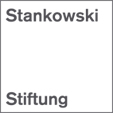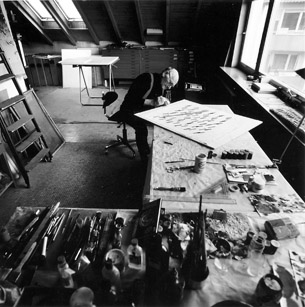|
|
|||
|
Life |
Anton Stankowski
A Survey 1929 Stankowski moved to Zurich, where he worked at the renowned advertising studio of Max Dalang. This is where he developed ‘constructive graphic art’ with his new photo- and typographic view. His friends in Zurich Richard Paul Lohse, Heiri Steiner, Hans Neuburg, as well as Hans Coray, Hans Fischli, Herbert Matter, Ernst A. Heiniger, Verena Loewensberg, Max Bill and others formed a cultural circle. During these years Stankowski completed his famous ‘Theory of Design’ in which he worked out fundamental forms of expression. 1934 he had to leave Switzerland due to the withdrawal of his official work permit and, after staying in Lörrach in 1938, he came to Stuttgart where he worked as a freelance graphic designer. 1940 he joined the forces and became prisoner of war in Russia until 1948. After returning, he worked for the ‘Stuttgarter Illustrierte’ as editor, graphic designer and photographer. 1951 he established his own graphic design studio on the Killesberg in Stuttgart. With Willi Baumeister, Max Bense, Walter Cantz, Egon Eiermann, Mia Seeger and others a new cultural circle developed. He taught in Ulm at the College of Design as visiting professor in 1964. His work on the graphic design field for IBM, SEL etc., especially his ‘functional graphic designs’ are exemplary. In the 1960’s he created the now legendary ‘Berlin layout’, the city’s visual identity, as well as the word trademarks IDUNA and VIESSMANN. 1969–1972 Anton Stankowski was chairman of the Committee for Visual Design for the Olympic Games in Munich. 1972 Karl Duschek
joined the graphic art studio Stankowski und Partner
which he was in charge of since 1975 (from 1981
Stankowski+Duschek). Karl Duschek died in 2011, the
graphic art studio was closed 2012. The 1970’s saw the creation of famous signmarks, such as the one for the Deutsche Bank, the Münchner Rückversicherungen, REWE and and Olympic Congress Baden-Baden. In the meantime a multitude of further sign- and workmarks, or visual identities respectively, have been developed. For Anton Stankowski there was no separation between free and applied art. Many of his photographic and painterly works flow into his functional graphic design. From the mid 1970’s onwards he increasingly turns to painting. His painterly oeuvre from the late 1920's to the late 1990's shows a continuity of constructive-concrete art. The exhibitions from 1928 onwards in the fields of graphic art, painting and photography point out the same way. 1976 the land of Baden-Wurttemberg confers on him a professorship, and Anton Stankowski, who is seen as a pioneer of graphic design, receives innumerable awards and tributes, the most recent being the Molfenter Award of the City of Stuttgart in 1991. 1983 Anton Stankowski establishes the non-profit Stankowski Foundation which continously awards persons and institutions bridging the separation of free and applied art and design. Like Stankowski himself. In December 1998 Anton Stankowski was given the Harry Graf Kessler Award, the honorary award of the German Artist Union, for his life’s work. Anton Stankowski died on December 11, 1998, in Esslingen/Neckar.
|
|
|

